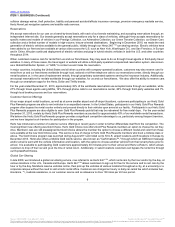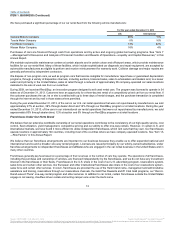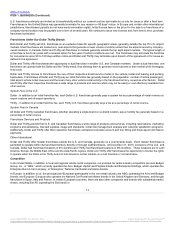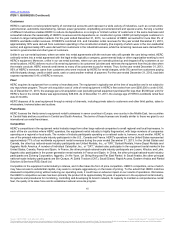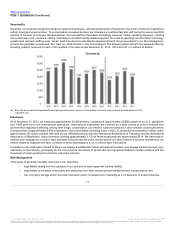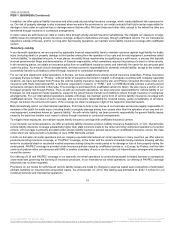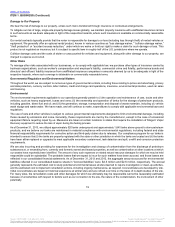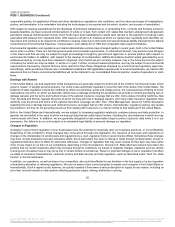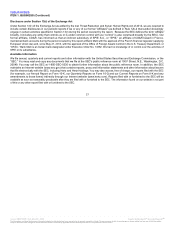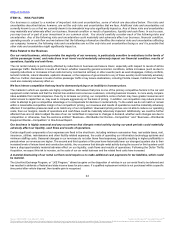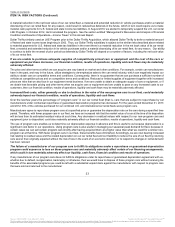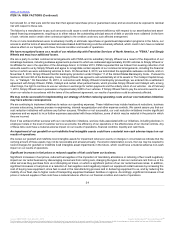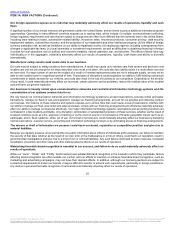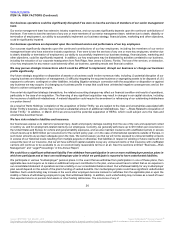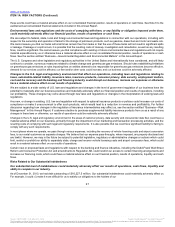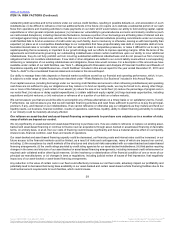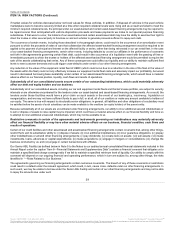Hertz 2013 Annual Report Download - page 22
Download and view the complete annual report
Please find page 22 of the 2013 Hertz annual report below. You can navigate through the pages in the report by either clicking on the pages listed below, or by using the keyword search tool below to find specific information within the annual report.
Table of Contents
Damage to Our Property
We bear the risk of damage to our property, unless such risk is transferred through insurance or contractual arrangements.
To mitigate our risk of large, single-site property damage losses globally, we maintain property insurance with unaffiliated insurance carriers
in such amounts as we deem adequate in light of the respective hazards, where such insurance is available on commercially reasonable
terms.
Our rental contracts typically provide that the renter is responsible for damage to or loss (including loss through theft) of rented vehicles or
equipment. We generally offer an optional rental product, known in various countries as “loss damage waiver,” “collision damage waiver,”
“theft protection” or “accident excess reduction,” under which we waive or limit our right to make a claim for such damage or loss. This
product is not regulated as insurance, but it is subject to specific laws in roughly half of the U.S. jurisdictions where we operate.
Collision damage costs and the costs of stolen or unaccounted-for vehicles and equipment, along with other damage to our property, are
charged to expense as incurred.
Other Risks
To manage other risks associated with our businesses, or to comply with applicable law, we purchase other types of insurance carried by
business organizations, such as worker's compensation and employer's liability, commercial crime and fidelity, performance bonds and
directors' and officers' liability insurance from unaffiliated insurance companies in amounts deemed by us to be adequate in light of the
respective hazards, where such coverage is obtainable on commercially reasonable terms.
Throughout the world, we are subject to numerous types of governmental controls, including those relating to prices and advertising, privacy
and data protection, currency controls, labor matters, credit and charge card operations, insurance, environmental protection, used car sales
and licensing.
Environmental
The environmental requirements applicable to our operations generally pertain to (i) the operation and maintenance of cars, trucks and other
vehicles, such as heavy equipment, buses and vans; (ii) the ownership and operation of tanks for the storage of petroleum products,
including gasoline, diesel fuel and oil; and (iii) the generation, storage, transportation and disposal of waste materials, including oil, vehicle
wash sludge and waste water. We have made, and will continue to make, expenditures to comply with applicable environmental laws and
regulations.
The use of cars and other vehicles is subject to various governmental requirements designed to limit environmental damage, including
those caused by emissions and noise. Generally, these requirements are met by the manufacturer, except in the case of occasional
equipment failure requiring repair by us. Measures are taken at certain locations in states that require the installation of Stage II Vapor
Recovery equipment to reduce the loss of vapor during the fueling process.
As of December 31, 2013, we utilized approximately 520 tanks underground and approximately 1,640 tanks above-ground to store petroleum
products, and we believe our tanks are maintained in material compliance with environmental regulations, including federal and state
financial responsibility requirements for corrective action and third-party claims due to releases. Our compliance program for our tanks is
intended to ensure that (i) the tanks are properly registered with the state or other jurisdiction in which the tanks are located and (ii) the tanks
have been either replaced or upgraded to meet applicable secondary containment, leak detection and spill, overfill and corrosion protection
requirements.
We are also incurring and providing for expenses for the investigation and cleanup of contamination from the discharge of petroleum
substances at, or emanating from, currently and formerly owned and leased properties, as well as contamination at other locations at which
our wastes have reportedly been identified. The amount of any such expenses or related natural resource damages for which we may be held
responsible could be substantial. The probable losses that we expect to incur for such matters have been accrued, and those losses are
reflected in our consolidated financial statements. As of December 31, 2013 and 2012, the aggregate amounts accrued for environmental
liabilities reflected in our consolidated balance sheets in “Accrued liabilities” were $2.5 million and $2.6 million, respectively. The accrual
generally represents the estimated cost to study potential environmental issues at sites deemed to require investigation or clean-up activities,
and the estimated cost to implement remediation actions, including ongoing maintenance, as required. Cost estimates are developed by site.
Initial cost estimates are based on historical experience at similar sites and are refined over time on the basis of in-depth studies of the site.
For many sites, the remediation costs and other damages for which we ultimately may be responsible cannot be reasonably estimated
because of uncertainties with respect to factors such as our connection to the site, the nature of the contamination, the involvement of other
potentially
19
Source: HERTZ CORP, 10-K, March 31, 2014 Powered by Morningstar® Document Research℠
The information contained herein may not be copied, adapted or distributed and is not warranted to be accurate, complete or timely. The user assumes all risks for any damages or losses arising from any use of this information,
except to the extent such damages or losses cannot be limited or excluded by applicable law. Past financial performance is no guarantee of future results.


